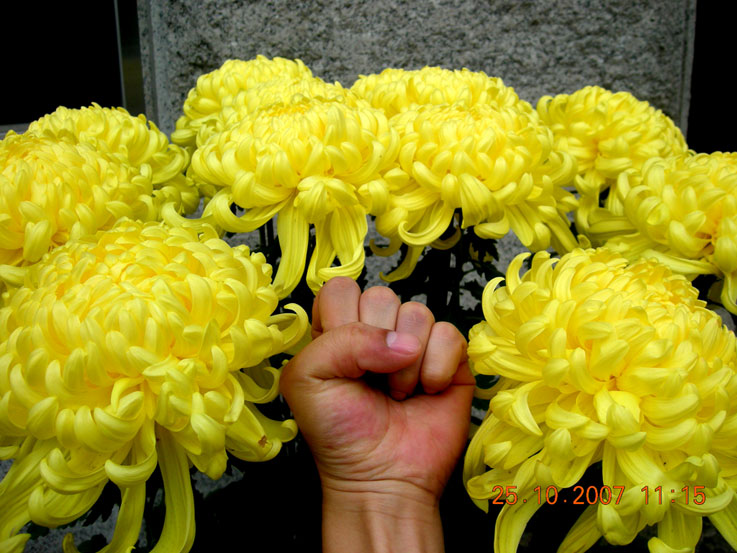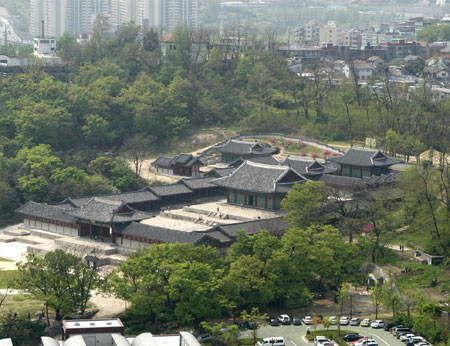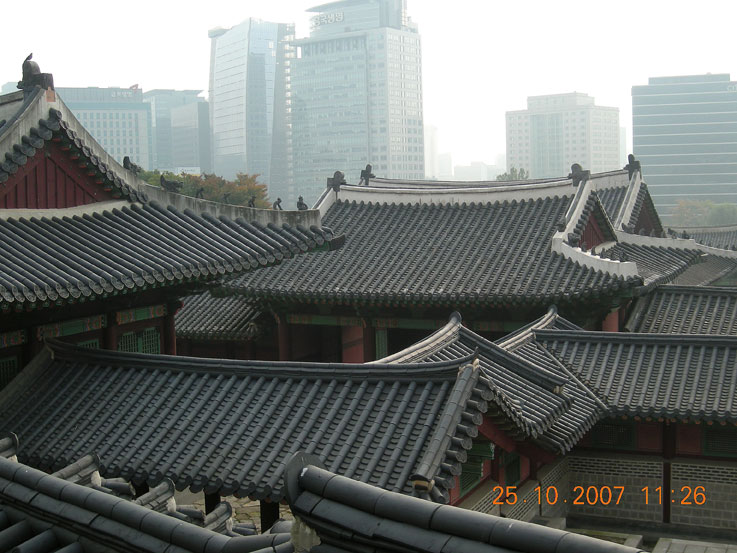 a royal villa in downtown seoul.
a royal villa in downtown seoul.
on the way between my home and central seoul's city hall and adjacent to the seoul museum of history is gyeonghuigung (palace) (경희국 aka gyeongdeokgung). as one of the "five grand palaces" of joseon, about 10 of the dyansty's kings stayed here during their daily excursions.  i couldn't help but admire these big chrysanthemums i saw on my walk to gyeonghuigung.
i couldn't help but admire these big chrysanthemums i saw on my walk to gyeonghuigung.
it's my understanding that it wasn't actually a palace, but rather, a royal villa. however, when the japanese burn everything down and there isn't much left, i guess the modern critera for what is called a "palace" is pared down. anyhow, construction occured between 1617-23, and once upon a time, the entire complex comprised some 100 different structures. most of the palace was destroyed... don't hold your breath ...by the japanese, but sungjeongjeon (숭정전) (the main hall) remains. a rendering of the compound circa 1820 shows an elaborate and extensive series of walls, homes and gardens that were connected by an arched bridge to deoksugung (palace), which is quite a ways to the southeast. aerial view of the palace compound.
aerial view of the palace compound.
at least four other significant buildings remain, including heunghwamun (흥화문), which is currently the palace's front gate. originally it faced east, but the japanese moved it here in 1932 to mark a shrine in honor of the occupiers first resident-general in korea. the original front gate is now the shilla hotel's main entrance and another major building is currently on the campus of dongguk university. its interesting to me how often these grand structures are moved around. gyeonghuigung rooflines with gwanghwamun skyscrapers.
gyeonghuigung rooflines with gwanghwamun skyscrapers.
the current complex is fairly modest. an hour is plenty to take a lesiurely walk admiring the architecture and reading the info plaques. when i was there i virtually had the place to myself, and there were several places both in the palace or in the grounds where it might be nice to bring a book. head on over to the seoul museum of history afterwards, if you like. anyhow, the symmetrical and serene grounds of this former royal villa are a nice counterweight to the busy chaos of nearby gwanghwamun. a roof tile detail.
a roof tile detail.
getting there:→ take subway line 5 to gwanghwamun station (exit #7) and walk west 400 meters. free. open 09:00-18:00. closed mondays.
07 December 2007
field trip #4: gyeonghuigung
posted by:
matt
at
16:30
![]()
topics: city life, field trip
Subscribe to:
Post Comments (Atom)
Archive
Labels
- city life (129)
- cityplan (8)
- expats (21)
- family (33)
- field trip (25)
- food (18)
- friends (61)
- history (3)
- holidays (27)
- home (30)
- homo (67)
- konglish (13)
- maps (5)
- me (85)
- miscellany (54)
- neighbors (22)
- north korea (5)
- ocd (35)
- plants (9)
- race (15)
- snapshot (23)
- the king (1)
- travel (48)
- usa (45)
- wacky (50)
- work (44)
- 한류 (korean cultural wave) (4)








2 comments:
I think the pic of the yellow chrysanthymums & your fist should eb the new "yellow power" symbol.
ya. i like the thought of using a flamboyant yellow chrysanthemum as our power symbol. the one big catch, however, is the chrysanthemum's association with the japanese royal family. given japan's history with its neighbors, i guess it's a no-go. bummer dude.
Post a Comment